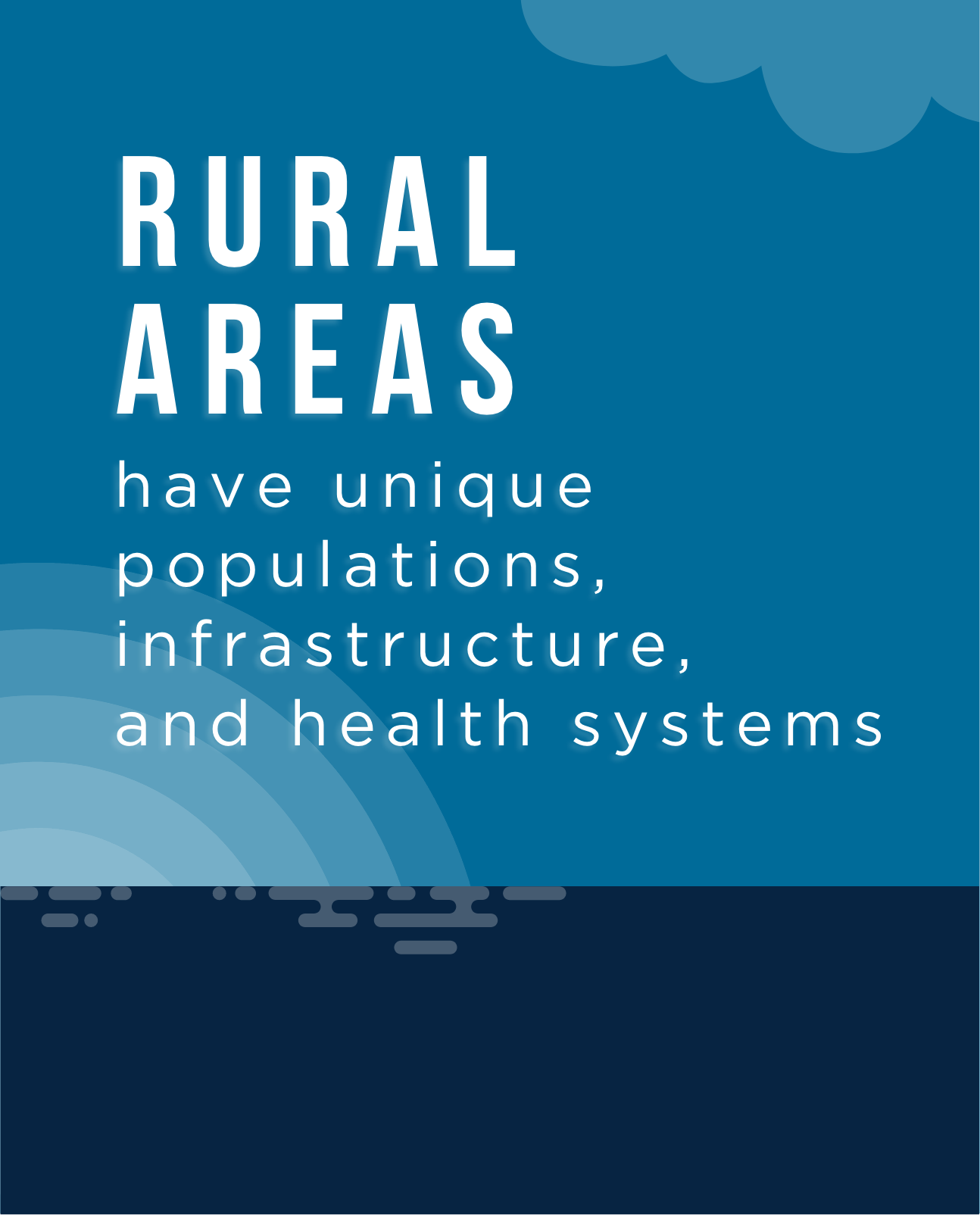Rural Health

Overview
There are significant regional and demographic differences among rural communities in the United States. Although their locations may differ, many rural Americans share common beliefs and values, such as resilience, self-reliance, and pride in the communities where they live.
These beliefs, coupled with the close social connections, can contribute to successful health interventions. However, some elements of rural communities can make population health interventions more challenging.1 This may mean developing and evaluating new interventions or adapting existing interventions to account for the specific demographic, economic, and health care needs of individual communities.
CDC Rural Health Policy Briefs
To address health disparities in rural areas, you may want to consider using policies that address population health. These policies can reach beyond health care and offer opportunities to make an impact where people live, learn, work, and play.
CDC rural health policy briefs provide examples of policy options to address public health issues. They include information on the background and significance of the issue, as well as case examples.
- Providing Diabetes Self-Management Education and Support for Rural AmericansThis policy brief presents a selection of potential policies and practices that may help rural residents access Diabetes Self-Management Education and Support.
- Preventing and Treating Cancer in Rural AmericaThis policy brief presents a selection of potential policies and practices that may help prevent and treat cancer in rural areas.
- Access to Mental Health Services for Children in Rural AreasThis policy brief presents a selection of potential policies and practices that may help rural children with mental, behavioral, or developmental disorders access behavioral health services.
- Protecting Rural Americans from Motor Vehicle DeathsThis policy brief presents potential policies that could increase seat belt use by rural Americans.
- Preventing Opioid Overdoses in Rural AmericaThis policy brief presents a selection of policy options and other strategies that may address factors affecting opioid overdoses in rural America.
- Preventing Suicide in Rural AmericaThis policy brief presents a selection of potential policies and practices that may address factors leading to suicide in rural areas.
NCHS Data Briefs
Healthcare Providers & Facilities
- Physician Assistant and Advance Practice Nurse Care in Hospital Outpatient Departments: United States, 2008–2009
- Role of International Medical Graduates Providing Office-based Medical Care: United States, 2005-2006
- State Variability in Supply of Office-based Primary Care Providers: United States, 2012
- Rural Residents Who Are Hospitalized in Rural and Urban Hospitals: United States, 2010
- Rural and Urban Hospitals’ Role in Providing Inpatient Care, 2010
Healthcare Services
- Mental Health Treatment Among Children Aged 5–17 Years: United States, 2019
- Mental Health-related Physician Office Visits by Adults Aged 18 and Over: United States, 2012–2014
Child and Adult Mortality
- Rates of Alcohol-induced Deaths Among Adults Aged 25 and Over in Urban and Rural Areas: United States, 2000–2018
- Increase in Drug Overdose Deaths Involving Cocaine: United States, 2009–2018
- Urban–rural Differences in Suicide Rates, by Sex and Three Leading Methods: United States, 2000–2018
- Suicide Mortality in the United States, 1999–2017
- Unintentional Injury Death Rates in Rural and Urban Areas: United States, 1999–2017
- Urban–rural Differences in Drug Overdose Death Rates, by Sex, Age, and Type of Drugs Involved, 2017
- Deaths From Unintentional Injury Among Adults Aged 65 and Over: United States, 2000–2013
- Differences in Stroke Mortality Among Adults Aged 45 and Over: United States, 2010–2013
Infant Mortality
- Differences Between Rural and Urban Areas in Mortality Rates for the Leading Causes of Infant Death: United States, 2013–2015
- Infant Mortality Rates in Rural and Urban Areas in the United States, 2014
Maternal and Infant Health
- Teen Birth Rates for Urban and Rural Areas in the United States, 2007–2015
- Urban and Rural Variation in Fertility-related Behavior Among U.S. Women, 2011–2015
- Trends in Fertility and Mother’s Age at First Birth Among Rural and Metropolitan Counties: United States, 2007–2017
Tribal Health
Rural-Focused MMWRs
2019
November 8, 2019
- Lung Cancer Incidence in Nonmetropolitan and Metropolitan Counties — United States, 2007–2016
- Potentially Excess Deaths from the Five Leading Causes of Death in Metropolitan and Nonmetropolitan Counties — United States, 2010–2017
October 18, 2019
August 23, 2019
June 28, 2019
June 21, 2019
June 14, 2019
May 3, 2019
January 1, 2019
2018
August 24, 2018
June 15, 2018
February 23, 2018
Featured Resources
CDC Rural Health Research and Resources
CDC’s rural health website includes information and examples of successful public health interventions for rural communities. The website also hosts CDC’s MMWR series which provide data on health issues affecting rural Americans.
Federal Office of Rural Health Policy (FORHP)
FORHP advises the Secretary of the Department of Health and Human Services about health care issues affecting rural communities.
Rural Health Information (RHI) Hub
The RHIhub is a clearinghouse of information on rural health issues. It also provides current resources on rural health care and population health including toolkits and models for programs that work in rural communities.
The Rural Health Research Gateway provides access to research conducted by the Rural Health Research Centers, including rural health research products and journal articles.

